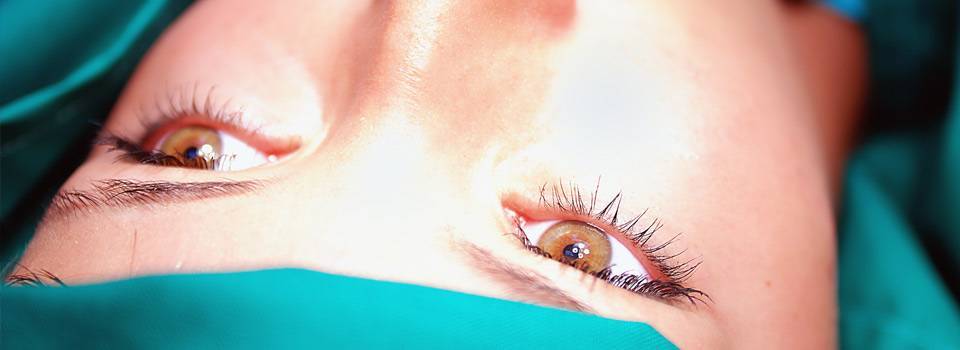What is strabismus surgery?
Strabismus, also known as “crossed-eyes” occurs when the two eyes are unable to achieve proper alignment to focus on an object. One eye is generally able to look directly at the object, while the other eye turns in a different direction.
Strabismus affects up to five percent of the population.
Strabismus surgery involves loosening or tightening the eye muscles in order to achieve proper alignment of the eyes. This type of surgery is recommended for all types of eye turns, including esotropia, exotropia, hypertropia, and hypotropia.
How effective is strabismus surgery?
Strabismus surgery is effective 80-90 percent of the time. Some patients, depending on their age and type of strabismus, will require multiple procedures for optimal results.
Will strabismus surgery give me clear vision?
If you or your child has been diagnosed with strabismus, surgery is an effective way to improve eye alignment.
However, it is important to understand that while surgery will correct the eye turn to help your eyes appear aligned, it cannot stimulate the two eyes to work together for clear vision.
Therefore, your eye doctor may recommend a program of vision therapy to improve eye coordination and eye teaming skills— which will also ensure that the eyes remain aligned.
What is a recession procedure?
A recession is used when the muscle is too tight. This procedure involves relocating the muscle to a different area— detaching the affected extraocular muscle from the eye and reattaching it farther back on the eye. By altering its position, the muscle is weakened, leading to improved alignment.
What is a resection procedure?
A resection is used when the muscle is too weak to hold the eye in its proper place, and consequently causes the eye to turn. This procedure involves strengthening the extraocular muscle by shortening it, and then reattaching it to its original position.
What is an adjustable suture procedure?
This procedure is performed following a recession or resection procedure in which adjustable sutures were used. During this procedure, the surgeon adjusts the sutures that hold the extraocular muscles in place, and either tightens or loosens them to improve the surgical results and achieve optimal alignment.
This surgery is generally only performed in adults, as the patient remains awake during the procedure with only a local anesthetic. For children with strabismus, a regular suture is typically used.
All sutures will dissolve on their own within about six weeks.
Contact an eye doctor near you to learn more about strabismus surgery and to discuss if this procedure is best for you or your child.
SEE RELATED: What Is Intermittent Strabismus?
Is strabismus surgery safe?
Yes.
While all surgical procedures carry a risk, the risks associated with strabismus surgery, including infection, bleeding, or excessive scarring, are low. The main risk of strabismus surgery involves under correction or overcorrection. Complications that lead to vision loss are very rare.
Will I be awake during surgery?
While most children undergo general anesthesia, adults are usually given the option for conscious sedation with a local anesthetic. The surgery is performed in a hospital or surgical center, and is typically an outpatient procedure.
What to expect after strabismus surgery
After strabismus surgery, your eyes will look red and feel sore. Some people experience a foreign body sensation in which they feel like something is stuck in their eye. This is due to the sutures and will disappear as the sutures dissolve in the next six weeks.
You may notice blood in the inside or outside corner of your eye, in the surgical area— this is normal and will subside within two to three weeks.
Other symptoms you may experience in the first few days after surgery include:
- Swollen eyelids
- Light sensitivity
- Mild blurry vision
- Double vision
Many eye doctors will prescribe an antibiotic eye drop or ointment to be used for a few days post-surgery— be sure to use your medication as directed by your doctor to avoid post-surgical complications.
For the first few days following surgery, expect to be off your feet and resting. Your doctor will let you know when it is safe to resume normal activities— usually within a few days post-surgery.
Caution: Avoid saunas, hot tubs, and swimming pools for three weeks after surgery to reduce your risk of infection.
Which symptoms indicate a problem?
Watch for signs of an infection or slipped muscle within the first week after surgery:
- Vision loss
- Increasing redness
- Green discharge
- Severe pain during eye movement
- Inability to move your eye
If you notice any of these symptoms, contact an eye doctor or emergency medical services immediately.
How do I know if the surgery was successful?
The first few days after surgery will provide a good indication of the success of the surgery. However, eye alignment can change over time and the final outcome of the surgery may not be confirmed until your eye has healed, typically around six weeks post-surgery.
Most children under the age of 10 will need multiple procedures to obtain optimal results.
LEARN MORE: Guide to Eye Turns
Schedule an appointment with an eye doctor to discuss any concerns you may have about an eye turn or strabismus surgery.


